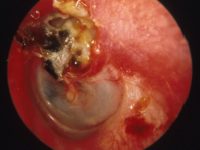Ear Otology
Procedures
Cholesteatoma

This is a type of Chronic Otitis Media where an abnormal sac of skin grows in the middle ear behind the eardrum. It is usually due to repeated infection and poor Eustachian tube function, which causes an ingrowth of the skin of the eardrum. It is a progressive infection and can increase in size and destroy the surrounding bone of the ear.
The symptoms includes foul smelling ear discharge and hearing loss.
If not addressed early can lead to serious complications such as dizziness, facial muscle paralysis and meningitis or brain abscess.
Initial treatment may consist of a careful cleaning of the ear, antibiotics, and ear drops. This aims to stop drainage in the ear by controlling the infection or otitis media. The extent or growth characteristics of a cholesteatoma must also be evaluated using a CT scan and hearing tests.
Most patients with a cholesteatoma would require surgical intervention. This is carried out by a mastoidectomy and tympanoplasty. The primary purpose of the surgery is to remove the cholesteatoma and infection and achieve an infection-free, dry ear. Hearing preservation or restoration is the second goal of surgery. Such reconstruction is performed by repairing the ossicles – tiny bones of hearing (ossiculoplasty).
In cases of severe ear destruction, reconstruction may not be possible in one operation; and therefore, a second stage operation may be performed six to twelve months later. The second operation will attempt to restore hearing and, at the same time, inspect the middle ear space and mastoid for residual cholesteatoma.

